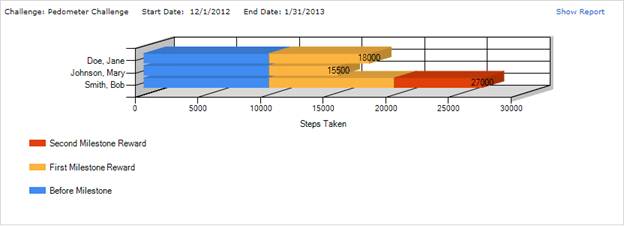The Fitness Challenge Handbook
Running The Challenge
An effective communication plan will ensure that your challenge runs smoothly for employees and admins
Communications
Communications is the key to running a successful challenge. From generating interest in the program to building teams to reporting on ROI to stakeholders, effective communications is what pulls it all together. However, no communications are as important to your participants as feedback on current standings and answering questions during the challenge.Feedback
Now that your employees are engaged in the challenge and data is being collected, they are going to want updates on how the competition is progressing; otherwise, they will quickly lose interest. So the question is not if feedback should be provided, it’s how often and in what form.
The most effective form of challenge feedback is a leader board. With a leader board, you display a chart (typically bar chart)
that includes the names of all participants or teams on the y-axis and their progress on the x-axis. Alternately, you could
mask the names of individuals for challenges that might include sensitive information such as weight or BMI.


Generally speaking, the participant with the longest bar would be the leader followed by the next longest bar and so on. This
chart could be delivered in either printed form, a PDF file or displayed on a web page. Regardless of distribution method, the
leader board should be available to all participants and other challenge stakeholders. One obvious problem with this approach
is very large challenges where there are hundreds of participants. In this case, you may want to show each user their standings
along with the standings of the top thirty or forty participants.
Another exception to providing a full leader board would be individual challenges where participants are competing against a
goal as opposed to one another. For this type of challenge, you may decide to only show each user where they stand in reaching
their goals.
Fielding Questions
Fielding questions is an important yet often overlooked aspect of your communication plan. This process starts by creating the Challenge Definition Document in the design phase which is distributed to all potential participants in the launch phase. Having a clearly-defined challenge document available will greatly reduce the number of questions and provide a guideline for both participants and administrators.
If your participants still have questions after referring to the Challenge Definition Document, a single point of contact
should be made available for responding to inquiries. If the same questions are asked repeatedly, you can assume the challenge
document needs to be updated. While I would not recommend changing the rules mid-challenge, adding a list of frequently asked
questions at the end of the Challenge Definition Document would certainly be advised.
Reinforcing Interest
It is inevitable that many participants will lose interest through the course of a challenge. Although we have discussed ways of mitigating this problem such as short challenge cycles and using teams, some participants will still lose motivation. This is particularly true if it becomes clear that a few high-performing teams or individuals will easily win the challenge awards.
The best way to combat fitness challenge fatigue is good communications and positive reinforcement. Emphasize the true benefit
of getting into better shape for individuals and what they have already accomplished. Pick out a few of the average-performing
participants and, with their permission, feature their experience in a challenge update newsletter. It also never hurts to
amend the challenge at some point to add a modest award to everyone who hits a minimum performance goal such as losing 5 pounds
in a weight loss competition.
